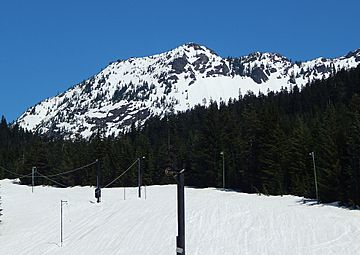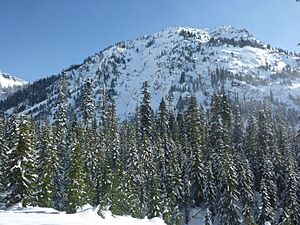Kendall Peak facts for kids
Quick facts for kids Kendall Peak |
|
|---|---|

Kendall Peak seen from Sahalie Ski Club
|
|
| Highest point | |
| Elevation | 5,784 ft (1,763 m) |
| Prominence | 344 ft (105 m) |
| Geography | |
| Parent range | Cascade Range |
| Topo map | USGS Snoqualmie Pass |
| Climbing | |
| Easiest route | Scrambling |
Kendall Peak is a mountain in Washington state. It sits right on the border between King County and Kittitas County. This peak is part of the beautiful Alpine Lakes Wilderness area, high up in the Cascade Range.
You can find Kendall Peak about two miles northeast of Snoqualmie Pass. It's on land looked after by the Mount Baker-Snoqualmie National Forest. Rain and melting snow from the east side of the mountain flow into Silver Creek. This water eventually reaches the Columbia River through the Yakima River. On the west side, water drains into the South Fork Snoqualmie River via Commonwealth Creek. The famous Pacific Crest Trail goes along its western side. A part of this trail, called the Kendall Katwalk, is very exposed. The closest taller peak is Red Mountain, which is about 0.9 miles (1.4 km) to the north.
Contents
Understanding Kendall Peak's Climate
Kendall Peak is located in a marine west coast climate zone. This means it gets a lot of influence from the ocean. Most weather systems start in the Pacific Ocean. They then travel northeast towards the Cascade Mountains.
How Weather Affects the Cascades
When these weather systems reach the Cascade Mountains, the peaks force the air upwards. This process is called Orographic lift. As the air rises, it cools down and drops its moisture. This moisture falls as rain or snow onto the Cascades. Because of this, the western side of the Cascades gets a lot of rain and snow. This is especially true during the winter months.
Seasonal Weather Patterns
In winter, the weather is usually cloudy. However, during summer, high-pressure systems often form over the Pacific Ocean. These systems bring clear skies and little to no clouds. Because of the ocean's influence, the snow in this area tends to be wet and heavy. This type of snow can lead to a high risk of avalanches.
Exploring Kendall Peak's Geology
The Cascade Range has a very rugged landscape. You can see sharp peaks, long ridges, and deep valleys carved by glaciers. Many years ago, huge geological events shaped this area. These events created the varied landscape and big changes in elevation. These changes in turn led to different climates and types of plants in various ecoregions.
How the Cascades Were Formed
The story of the Cascade Mountains began millions of years ago. This was during the late Eocene Epoch. At that time, the North American Plate was slowly moving over the Pacific Plate. This movement caused many periods of volcanic activity.
The Impact of Glaciers
During the Pleistocene period, which was over two million years ago, glaciers repeatedly moved across the land. As they advanced and retreated, they scraped and shaped the landscape. They left behind large amounts of rock debris. The river valleys in the Cascades often have a "U" shape. This shape is a direct result of these recent glaciers. The combination of land uplift and faulting, along with glaciation, has created the tall peaks and deep valleys we see today.




